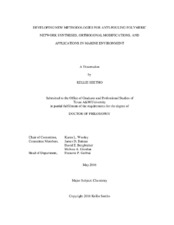| dc.description.abstract | Biofouling on ship hulls and other surfaces calls for immediate attention as fouling organisms increase both friction and weight of vessels, resulting in wasted fuel consumption, travel time, and cleaning resources. There are currently many efforts to develop polymeric networks as anti-fouling coatings to replace traditional anti-fouling paints, which contain toxic compounds. This dissertation focuses on the development of new methodologies for anti-fouling polymeric network syntheses, orthogonal modifications, characterization and anti-fouling properties for marine anti-fouling applications.
A terpolymer network based on hyperbranched fluoropolymers crosslinked with poly(ethylene glycol) and polydimethylsiloxane that displayed improved fouling releasing properties was generated. Methodologies and experiments were designed and performed to investigate the stability and crosslinking efficiency of the network when the crosslinking polymers were increased. The concept of using a three-component system was retained while changing each component. A ternary network of silsesquioxanes, an amphiphilic fluorinated compound and sulfobetaines was generated by thiol-ene click chemistry and to form coatings. The anti-fouling performances of the coatings were then tested against various marine fouling organisms.
A facile, two-step modification to generate an amphiphilic zwitterionic copolymer from a commodity copolymer was also explored. A copolymer containing hydrophobic units and reactive units was synthesized and subsequently modified to produce an amphiphilic, zwitterionic polymer. The amphiphilic zwitterionic polymer was covalently attached onto silanized glass with different crosslinking extents to form amphiphilic crosslinked networks. The surface properties of the resultant polymer coating can be easily tuned by varying the extent of cross-linking in the network. Anti-fouling studies of bovine serum albumin and Ulva zoospores suggest that this system displayed potential as an anti-fouling material.
Lastly, the thermal and mechanical properties of zwitterionic vs. blended ionic polymers were investigated. Different charged polymers were prepared by functionalizing poly[(allyl glycidyl ether)-b-(ethylene oxide)-b-(allyl glycidyl ether)] (P(AGE-b-EO-b-AGE)) with different charged thiols through highly efficient photoinitiated thiol-ene chemistry. Equimolar amounts of polymers with positive charged side chains and negative charged side chains were then mixed together and compared to polymers with zwitterionic side chains that possess similar charge densities. The bulk polymers were characterized by thermogravimetric analysis, differential scanning calorimetry, and dynamic mechanical thermal analysis to study the effect of the nature of ionic interactions of the charged polymers. | en |


